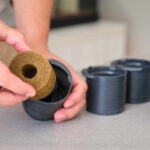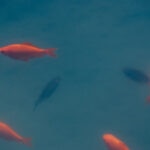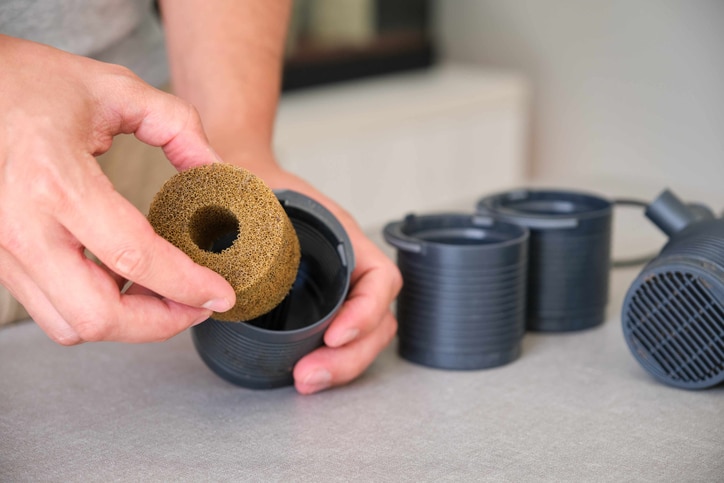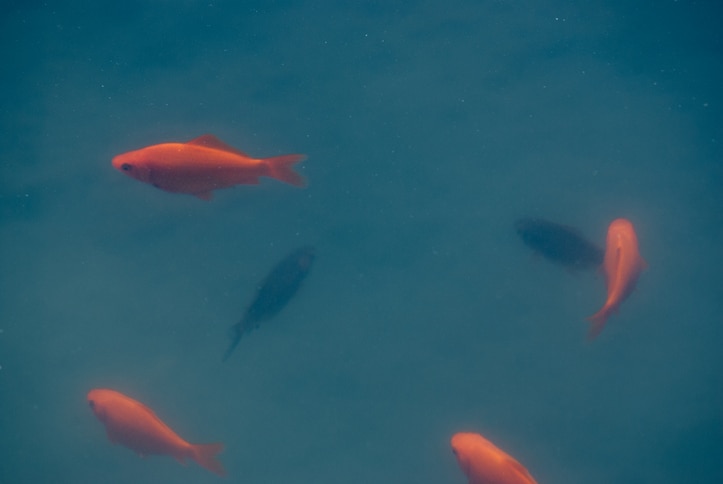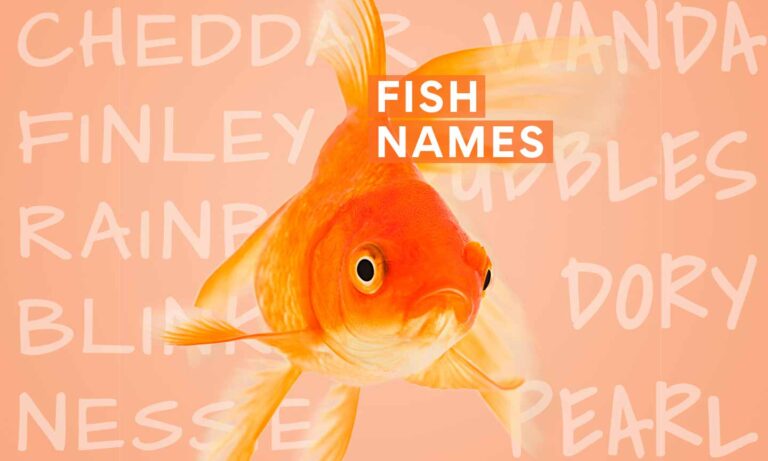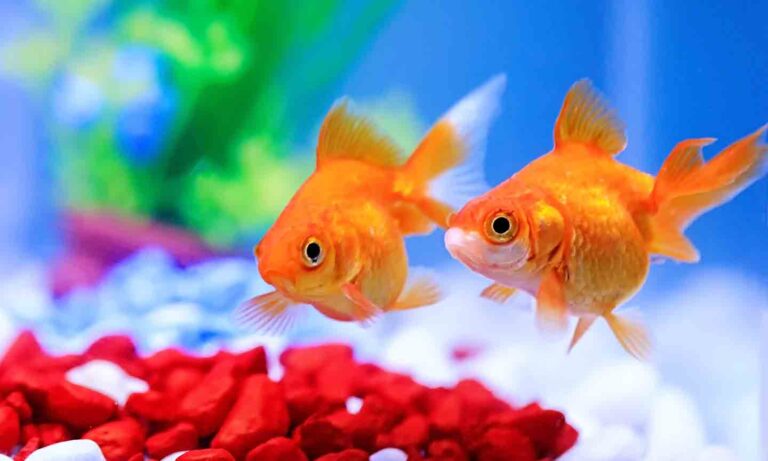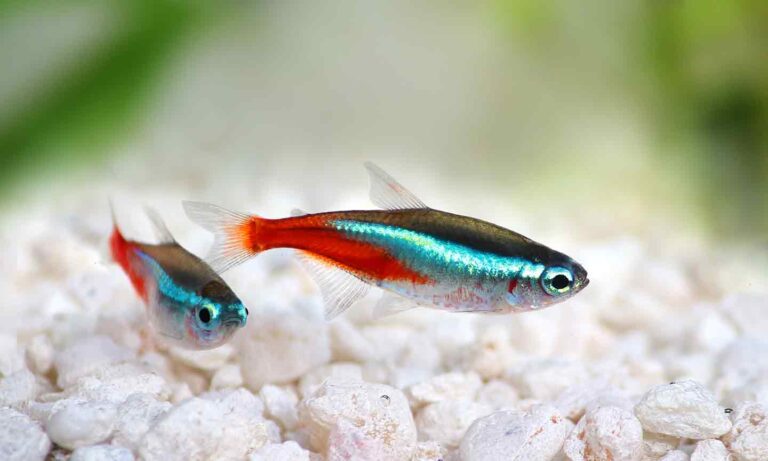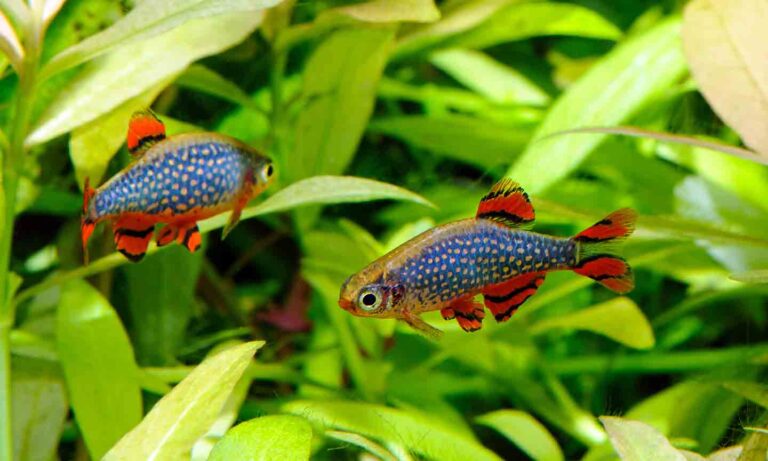Best Pet Fish For Children
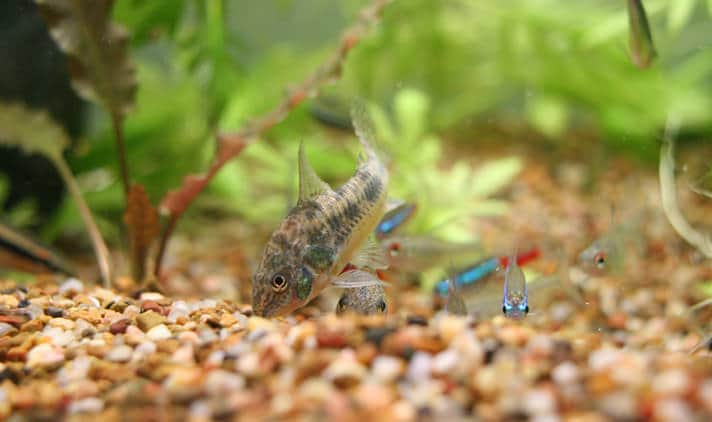
Photo by Chewy
What follows comes from just one fishkeeper’s experience (mine), and in no way do I claim this to be a definitive list. Probably no two aquarists’ lists of great beginner fish would be the same. There are so many choices! My list comes from what I’ve learned during more than 40 years of keeping tropical fish. I’m sure at least some of you will disagree with me. Not a problem — it’s a big hobby. This article is a starting point, make sure to research individual fish before you buy. What I’m going to propose are different groups of fish that are good beginning choices. Each group has a number of individual species or color varieties in it.
Criteria
Let’s look first as what we mean by good beginning fish. There are a number of factors by which a fish can qualify for inclusion in this select list of finned friends.
Hardy
The first qualification for a fish to be a good beginner’s species is that it must be very hardy. The fish must be able to put up with less-than-perfect living conditions (a little overfeeding, sometimes a lack of feeding, infrequent water changes, some overcrowding and so on). This doesn’t mean I condone improper fish care. I’m just being realistic, and the fact is that folks starting out in the hobby may not always provide their fish ideal living conditions. Beginner fish need to be able to take this kind of treatment and survive.
Peaceful
To qualify for inclusion here, a fish must be peaceful — not only toward other fish species but its own, as well. Put simply, fish that are highly territorial (with two exceptions mentioned later) or just plain nasty and tend to pick on or actually do battle with other fish are not acceptable. We want everyone to get along.
Easy to Feed
Beginner fish must be able to thrive (not just get by) with a diet completely composed of dry, prepared fish foods. There are many excellent brands of prepared food on the market, with a wide variety of formulations. In addition, there are many other packaged “treats,” such as freeze-dried brine shrimp, bloodworms and mosquito larvae. All of these provide a complete diet for most fish, but you still should feed a variety of the dry foods. This does not mean that you should refrain from feeding frozen or live foods, but these fish don’t need anything but prepared dry foods to do well.
Attractive
Now, we start really getting into opinions. The phrase “beauty is in the eye of the beholder” never applied more than to tropical fish. I’ve included fish I think are attractive.
Commercially Raised
One nice thing about the tropical fish hobby is you can enjoy it and find plenty of fish to choose from even if you limit yourself to those that have been raised commercially for the ornamental fish hobby. I’m not saying we should not keep fish that are caught wild, but there are so many species raised commercially there’s really no need to look further. Captive-raised fish are usually healthier and less stressed from capture and shipping, and buying them preserves wild populations, as well.
Working With Your Water
Keep fish that will do well in your tap water. Without getting into a discussion of the specifics of water chemistry, let’s briefly consider two things: pH and hardness. The pH is the measure of the acid/alkaline balance of water. Hardness is the measure of the dissolved solids in the water.
Water pretty much splits into two types: soft/acidic and hard/alkaline. You can bring a sample of your water to many local fish stores, and they will test it for you. Better yet, you can buy inexpensive test kits for pH and hardness, so you can monitor water conditions as they change in your fish aquarium. Particularly when starting out in the hobby, it is much easier and you will have more success if you keep fish that prefer your water conditions. Trying to make hard/alkaline water into soft/acidic water is difficult and somewhat expensive.
Making soft/acidic water into hard/alkaline water is a bit easier because you are adding elements to the water, not trying to remove them. Nonetheless, this is still something you should not deal with when beginning in the hobby. In addition to pH and hardness, we also have to consider whether we want to heat the aquarium for the fish or just leave it as a coolwater aquarium without a heater.
The Fish
I’m going to divide the groups of good beginner fish into the following groupings: two for unheated aquariums with average hardness and neutral pH, four tropical species for soft/acidic water and four tropicals for hard/alkaline water.
Unheated Aquariums
Danios
Danios are a family of fish, the most common of which are zebra danios, pearl danios and giant danios. There are numerous variations with long, flowing fins and different colors and/or patterns. Danios do best in a long aquarium, such as a 20 long, because they are actively swimming all the time, and they like plenty of room to swim the length of the aquarium before needing to turn around. They are schooling fish, so the more the merrier – you should have at least eight or 10 of each type to keep them at their best. All of the danios are prolific breeders and therefore are very inexpensive.
One very interesting fish that’s just now entering the hobby is a “phosphorescent” zebra danio. A gene for phosphorescence is “planted” into the DNA of a zebra danio, and the fish is reported to glow under the right conditions. Unlike the painted and dyed fish that are available in the hobby, this process does not harm the fish. They are also supposed to be sterile, so prices may be high for quite a while.
Soft/Acidic Water
Angelfish
Besides being my favorite fish, angelfish are great beginner fish. They come in many different varieties of markings and finnage and are very easy to keep. Although they can be acclimated to, and even bred in, water that is not soft and acidic, they do best at a pH in the low 6 range, and the softer the water, the better.
Remember that angelfish are cichlids, and therefore will become territorial when they mature, especially when they start to breed. When they reach adult size, if there are any small fish like cardinal or neon tetras, the angels may decide to supplement their diet with some protein-on-the-fin, in the form of any small fish they can consume. And yet, they are beautiful and easy to keep.
Dwarf Gouramis
This is an instance in which the fish breeders of the Far East have taken a fish that was already great and made it even better (at least to some). Starting with two kinds of gouramis, the regular dwarf gourami (Colisa lalia) and the honey dwarf gourami (Trichogaster [Colisa] chuna), breeders have produced some lovely color varieties. They also can manipulate the development of a spawn so that they get only male fish, which are much more colorful than the females.
Regular dwarf gouramis come in a few varieties of solid red and solid blue. The honey dwarf comes in a “red flame,” “sunset” and a beautiful golden variety. Any of the dwarf gouramis make excellent beginner fish for soft/acidic water. However, remember that most of what you see in the stores will be males, so if you want to attempt breeding them, you may have to ask the store to bring some females in especially for you.
Neon Tetras
Neon tetras originally came from the Amazon basin, and they prefer soft/ acidic water. In the Far East, primarily Hong Kong, neons are produced by the millions. Buy the large ones (about three-fourth inch), and buy them in schools of no less than eight or 10. Neons look best on darker (even black) gravel and really thrive in a densely planted aquarium.
A word of warning: In most stores, you will also see cardinal tetras. They look just like the neon, but the red line on the bottom extends from front to back (in neons, the red line is not as long). Cardinals can be difficult to keep, so do not be tempted – as a beginner – to select them over the neon.
Cory Cats
Every aquarium that has soft/acidic water should have at least one shoal of five to six cory cats (catfish in the genus Corydoras). Many cory cats are produced by fish farmers, and the most common ones that you can rely on being farmed are the albinos (Corydoras aeneas and C. paleatus). Other common species that do come from the wild include varieties of C. melanistius and C. punctatus. They are plentiful in the wild and easy to keep.
Hard/Alkaline Water
Livebearers
The best group of fish to start with that like hard/alkaline water are the livebearers. The easiest ones to keep are the platies and swordtails, both of which come in a breathtaking array of colors and finnage. A second group of livebearers that can be a little more difficult to keep are the mollies and the guppies, which are also available in many varieties. If you have success with platies and swordtails and want more challenging fish, you may want to consider mollies or guppies.
Livebearers do best with a little salt added to their hard/alkaline water (say, a tablespoon per 5 gallons). They should also have a lot of vegetable matter in their diet. Feed them some green flakes (Spirulina algae flakes are the best).
As their name implies, all these fish give birth to broods of live baby fish, usually about once every 30 days or so. You can save many of the babies if you have floating plants in the aquarium for them to hide in. You can then move the babies to an aquarium of their own. In addition to being easy to keep, livebearers are the best beginning fish to get to breed.
Plecostomus
Most fish of the genus Plecostomus (suckermouth catfish also known as “plecos”) you will see in fish stores for about $5 have been bred and raised in Florida in hard/alkaline water. They’ll do great in an aquarium with livebearers, Mbuna or Tanganyikan dwarf cichlid fish (the last two groups of fish we will be covering).
Make sure there is a cave or similar hiding area for each pleco to call its own; they feel most secure that way. In addition to ease of keeping, the other great reason to have plecos is that they eat algae and will keep your aquarium glass fairly clean. Sometimes, they will also eat soft-leaved plants, but if you feed them some Spirulina disks or pellets after turning off the lights, they will appreciate it (plecos feed mostly at night).
Tanganyikan Dwarf Cichlid Fish
From another East African rift lake, Lake Tanganyika, we have a group of dwarf cichlid fish of the genera Neolamprologus and Julidochromis that will absolutely thrive for beginners with hard/alkaline water. These fish will do best with a pH as high as 8.5 and extremely high hardness. All these fish will breed quite readily in a small aquarium of 10 or 15 gallons. It’s great fun to set up a 15-gallon aquarium with rocks, coral gravel and caves.
Start with six or eight of the same fish (my favorites are Neolamprologus brichardi and Julidochromis marlieri). Within eight to 10 months, fish in the group will pair off and get ready for breeding. You will know which fish are not the pair because they will be cowering in a corner at the top of the aquarium or pinned in a corner. Remove these fish — or else the pair will kill them – and the pair will claim the entire aquarium for their breeding territory. The brichardi will eventually set up a breeding colony with a dominant male, one or more females and the young babies from various spawns all hanging around a breeding cave. It’s a wonderful sight.
Alternatively, you can keep a larger aquarium (40 or 55 gallons) with two or three different species of Tanganyikan dwarf cichlid fish. As they mature, each species will claim a part of the aquarium as their own territory. They are easy to keep and easy to get to breed.
Five More Good Beginner Fish
By John Virata
Below is a list of five more fish that are ideal beginner fish. This list is to supplement the above list of best pet fish for children. I have kept each of these species multiple times over the last 30 years, in everything from 10 gallon tanks to my current community tank setup, a 55 gallon. You will find all of these fish at your local fish store. They are hardy, easy to keep, and make great pets. So here they are in no particular order (though I am privvy to the kuhli loaches!)
Betta
For many people, the Betta, or Siamese fighting fish (Betta splendens) is the fish that introduced people into the hobby, and there are many reasons why. Betta splendens is widely available, comes in a variety of colors, and with its long, flowing fins, is one of the most beautiful freshwater fish to keep. Male bettas can be easily found in most every local fish store and big box pet store. It is a staple fish that is generally very hardy, has minimal care requirements, and can have a nice demeanor as well.
While virtually all bettas that are in stores are in little plastic cups or small fish bowls, it is imperative that once brought home, the fish is moved into a larger aquarium. If kept alone, the betta can do well in a 2 gallon aquarium.
While two males cannot be kept in the same tank, the betta can coexist with other peaceful fish in a 5 gallon aquarium. Keep in mind that smaller fish such as neon tetras and even small guppies should not be kept with the betta, as the betta will often harass smaller fish. The betta is found in the wild in still and stagnant waters. In your fish tank, keep in mind that they don’t do well when there is a lot of agitation of their water. A gentle flowing filter is best. Tankmates can include fish that aren’t nippy, because the betta has long fins that fin nippers will tear up.
Avoid fish such as serpae tetras and tiger barbs as these fish are notorious fin nippers. Bettas aren’t particularly picky either when it comes to food. There are a lot of betta specific food on the market that come in sizes that perfectly fit the bettas mouth, but a high quality flake food is just as good. Crush it a bit with your fingers before you drop it in the tank and the betta will eat it up.
Guppy
The guppy (Poecilia reticulata) is one of the most popular fish in the trade. They come in a variety of colors and fin sizes, and are a hardy fish. The guppy does well in pairs, and given the correct water parameters, are easy to breed, which is one of the reasons that this fish makes an excellent beginner fish. In fact, the female can drop live babies every 30 days or so, so be mindful when stocking your tank. You can house up to three pairs of guppies in a 10 gallon tank, and more in a larger tank, but three pairs is plenty. If the guppy has babies, it is imperative that you remove the baby fish into another tank, as they will be eaten.
Guppies do well with other peaceful fish and are ideal in planted tanks or fish tanks with potted plants. Guppy tankmates include corydoras catfish, neon tetras, and even the secretive kuhli loach. Guppies are not picky eaters and can be fed a high quality flake food as well as frozen and freeze dried foods. You can use anything from a hang on the back to a sponge filter in your guppy tank, just make sure that the pump’s power is not so strong that it inhibits the guppy from freely swimming.
Black Molly
The black molly (Poecilia sphenops) is an endearing fish that is great for beginners due to several subjective factors. They are generally well mannered and peaceful, and they have a propensity to make lots of babies. Fairly peaceful, the black molly should be kept in multiples of a few females and one male. If kept in just a pair, the male may consistently harass the female, so it is best to spread the love amongst multiple females. The black molly will eat its offspring, so if you notice little black fish swimming in the tank, either place them into a separate tank, or ensure that there is an adequate number of plants both in the substrate as well as floating to provide ample hiding spots. Mollies thrive in temperatures ranging from 70 to 82 degrees Fahrenheit. They are also one of the few fish in the freshwater trade that can live in fresh, brackish, and saltwater, given they are acclimated to those conditions. The molly occupies the mid-top level of an aquarium and does well in a minimum 20 gallon tank and will do well with other peaceful fish.
Black Skirt Tetras
Black skirt tetras (Gymnocorymbus ternetzi) grow to about 2.5 inches in length and are best kept in multiples. A pair will do well in a quiet aquarium, but a shoal will provide for a more visually stunning display. The black skirt tetra is a fairly peaceful fish, unlike Serpae and other tetras. It should be housed in an aquarium with plenty of plants, rocks, and other structure to ensure that they can seek refuge when they want. They live at mid-level and can do well in both long and tall aquariums. They will eat most any prepared foods, including flake foods, frozen and freeze dried foods, and they especially enjoy live foods such as brine shrimp. Keep the black skirt tetra with other tetras, as well as corydoras catfish and other peaceful fishes.
The Kuhli Loach
The kuhli loach (Acanthophthalmus kuhlii) is one of those fish that are interesting due in part to its secretive behavior. While the guppy, black molly, black skirt tetra, and the betta live in the mid and upper portions of the water column in a fish tank, the domain of the kuhli loach is at the bottom and underneath the substrate. Yes, the kuhli loach stays hidden for most of the day and comes out often at night to feed. If you decide to keep a kuhli loach, make sure that you feed it a sinking food to ensure that the loach will have ready access to food on the bottom. Make sure that sinking food is not too big that it won’t fit into its mouth. Ensure that the tank has ample hiding places such as caves or pieces of driftwood and live plants that the kuhli loach can hide under, and when vacuuming your substrate during your water changes, be very careful with regard to the positioning of the vacuum, as you might suck up your kuhli loach! Kuhli loaches are fairly hardy animals that aren’t territorial nor are they a menace to other fish. Because they are a bottom dweller, they also make for a good cleanup crew for any uneaten foods that may float down to the bottom, to supplement the sinking food.
Conclusion
There are many different fish to choose from for the beginning hobbyist. It’s important that you know as much as possible about any fish you buy, so please read books and subscribe to magazines about fish. I strongly recommend you start with the fish in this article. Also, make sure you select fish best suited to your water conditions.
Above all else, please remember that local fish stores are a great source for advice, and should have the right products for your experience level and (most of all) good healthy fish for your aquarium. Start off right, and your chances of success are greatest. Good luck in keeping fish – the best hobby of them all.
Posted By: Chewy Editorial & John Virata
Featured Image: Via Martin Pool/Flickr
